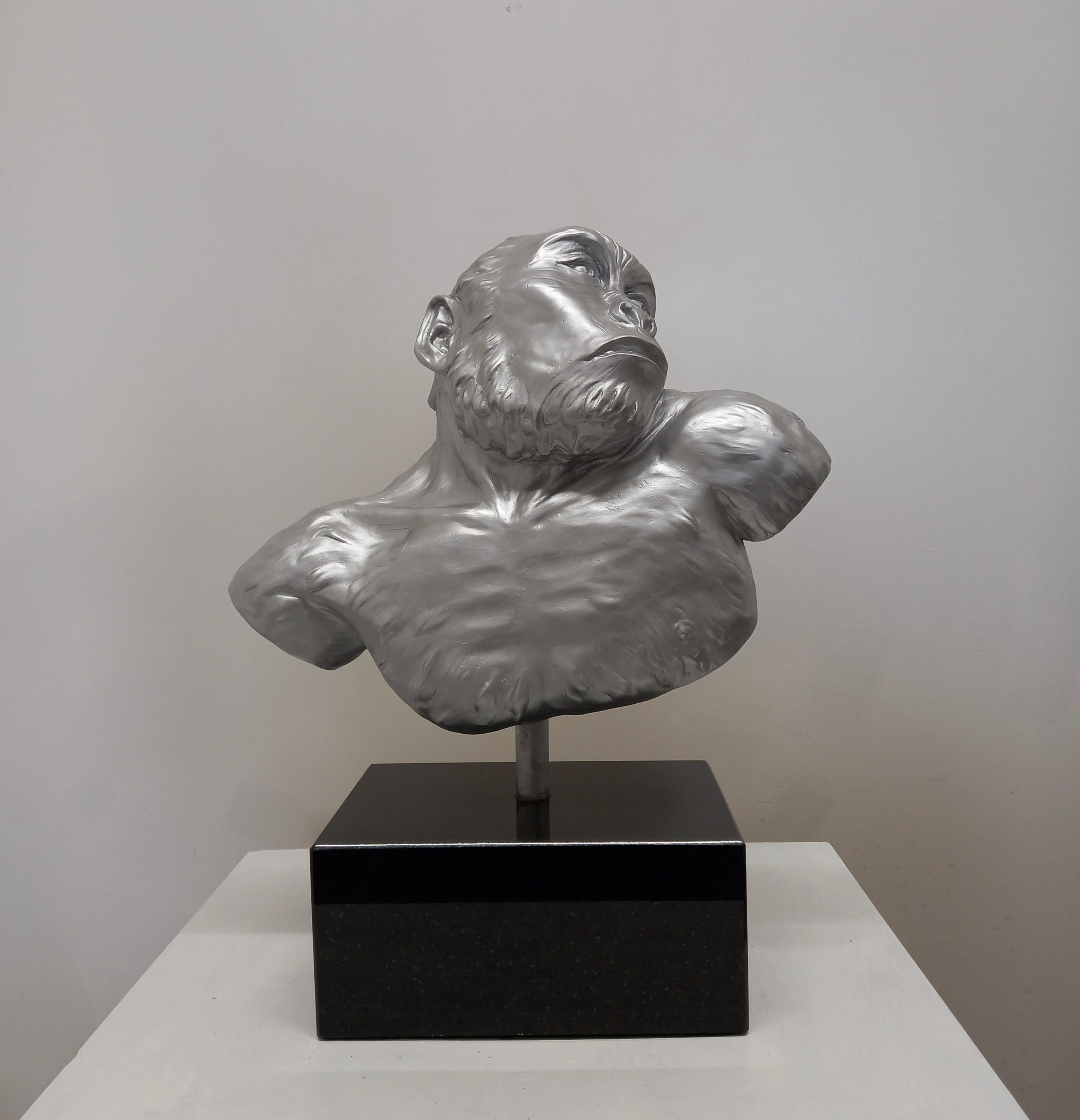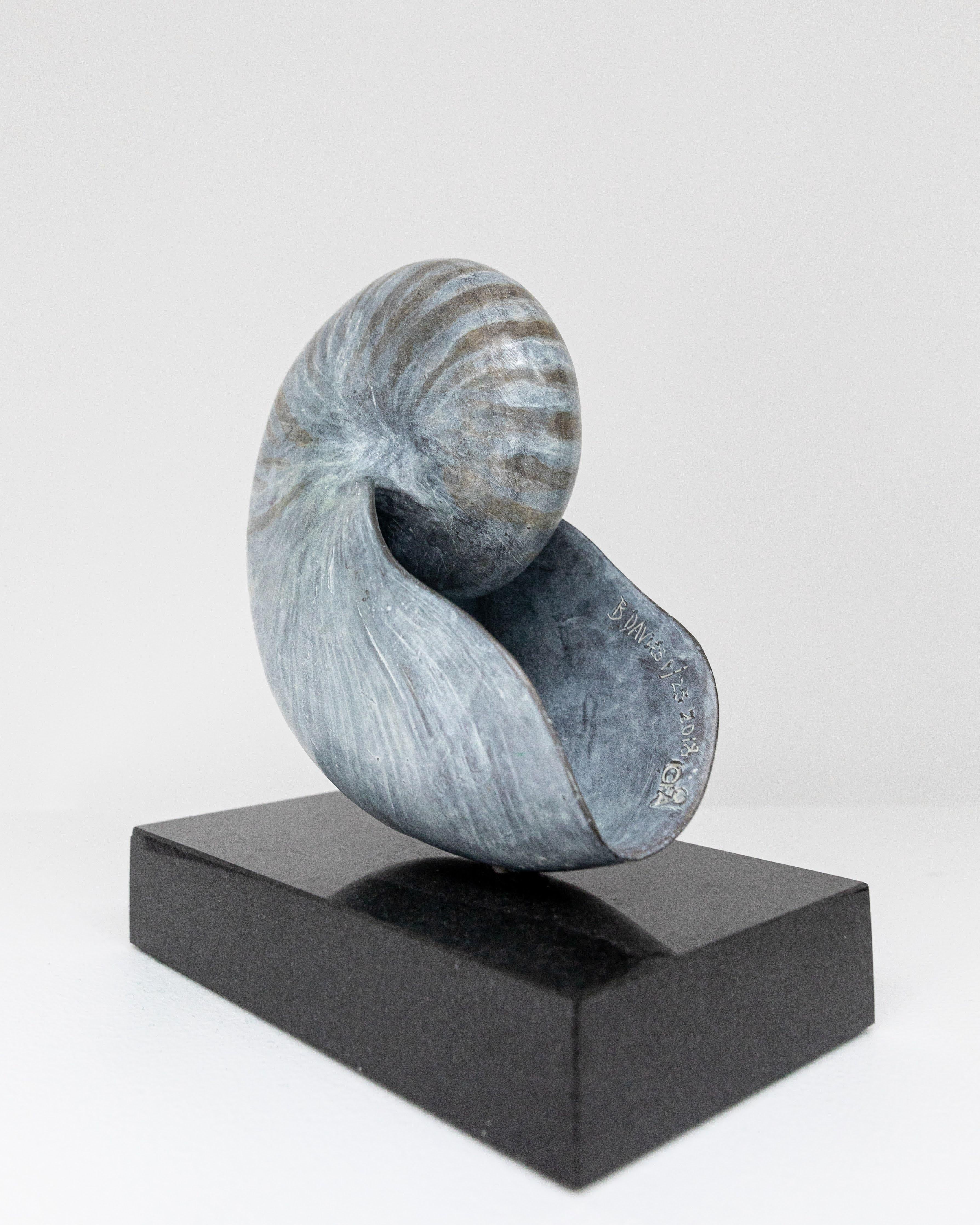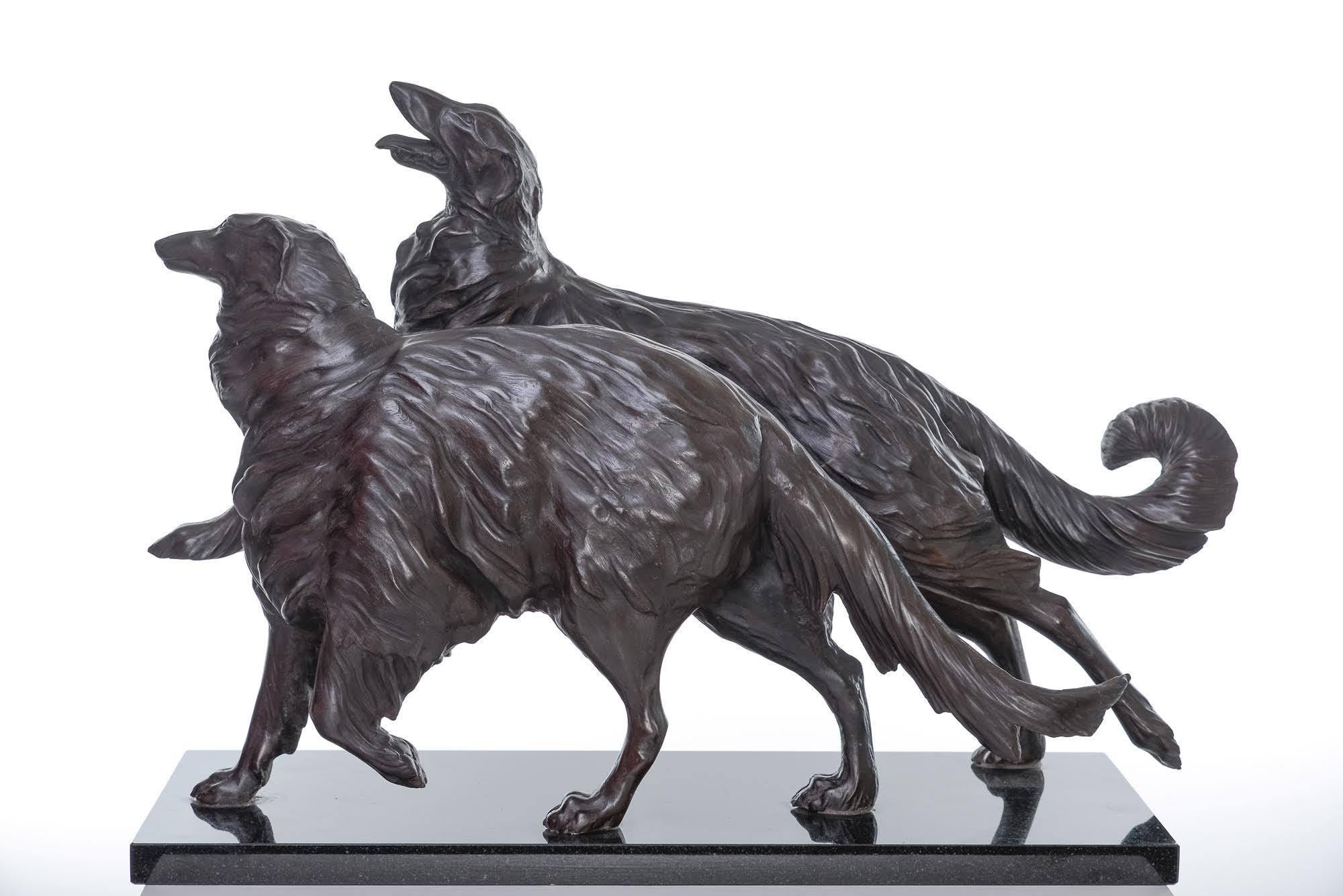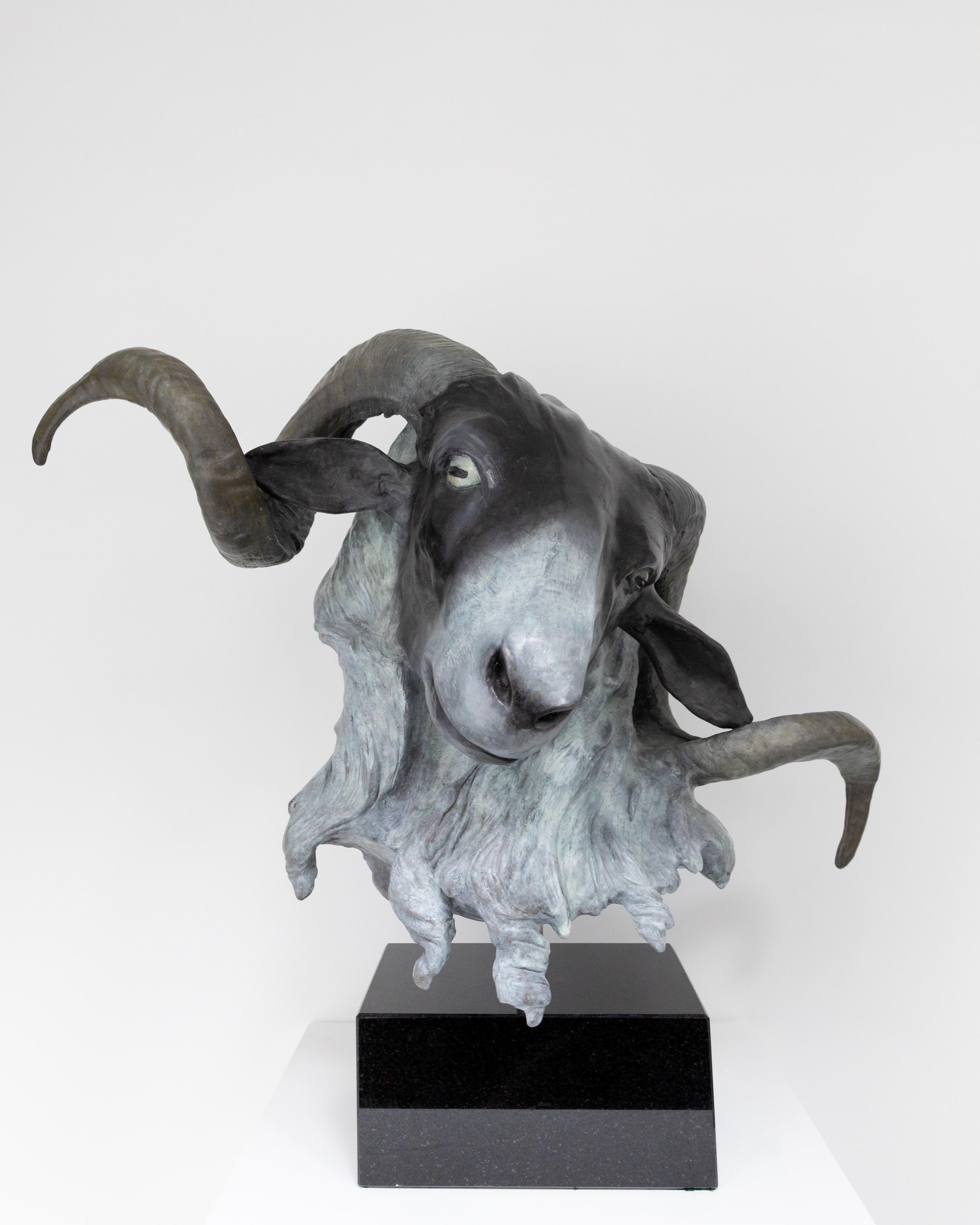Want more images or videos?
Request additional images or videos from the seller
1 of 10
Dog scratching its ear
About the Item
This amusing naturalistic sculpture in silver-plated pewter was probably made in the 17th century by Georg Schweigger. Inspired by a model created by another Nuremberg sculptor, Peter Flötner, it bears witness to the persistence during the baroque era of the naturalistic taste that emerged in the Renaissance. Intended as an ornament for some Kunstkammer, or cabinet of curiosities, this sculpture was a great success, as can be seen from the presence of similar works in many European museums.
1. Georg Schweigger
Georg Schweigger was a baroque sculptor and medal founder from Nuremberg, known mainly for his small-scale works in stone, carved wood and cast metal. His only large-scale work, the Neptune Fountain, has been in the Petershof Palace, the summer residence of the Tsars near St. Petersburg, since 1797. This monumental sculpture demonstrates his taste for the representation of movement, which we find in this small piece, inspired, as we shall see, by earlier models.
2. The success of a naturalistic theme
As is often the case in the history of art, the source of the Dog scratching his ear theme probably comes from an engraving, and more precisely from one made in Strasbourg in 1480 or in Aschaffenburg in 1481 by the Master of the Housebook, an anonymous engraver working in southern Germany at the end of the 15th century.
This engraving seems to have been Peter Flötner’s (1490 - 1546) source of inspiration. Peter Flötner was a sculptor and engraver who settled in Nuremberg in 1522. The Louvre Museum also has a gilded lead statuette dated between 1500 and 1515 (on deposit at the Musée de L'Œuvre in Strasbourg), which in turn is thought to have served as a model for other known statuettes.
This model was later taken up by the Frenchman Barthélemy Prieur (1526 - 1611), although it is not clear whether these two sculptors were directly inspired by the engraving of the Master of the Housebook or whether, as would seem more likely, Barthélemy Prieur was inspired by Peter Flötner. A sculpture attributed to Barthélemy Prieur, believed to date from the 1600s, was sold at Sotheby's Paris on 14 June 2022 for €18,270.
The later models attributed to Georg Schweigger often show variations on the Flötner one, such as the tongue hanging down or the tail raised (as in the model attributed to Barthélemy Prieur). The one presented here corresponds to the Flötner model, but the regularity of the original silver threaded fixing rods suggests that it was made after the beginning of the 17th century, and is therefore contemporary to Georg Schweigger’s activity.
The statuette of the Dog scratching his ear was a famous subject, of which several versions by different artists appear in many other museums, including the Grünes Gewölbe in Dresden, as well as the museums of Berlin (since 1701), Braunschweig, Vienna, Cleveland and Munich.
Main bibliographic elements :
U. Berger, V. Krahn, Bronzen der Renaissance und des Barock, Herzog-Anton Ulrich Museum, Braunschweig, 1994, pp.275 - 276, figs. 222 and 223.
V. Krahn, Von allen Seiten schön. Bronzen der Renaissance und des Barock, Berlin, 1996, p. 544, no. 204.
- Attributed to:Georg Schweigger (1613 - 1690, German)
- Dimensions:Height: 2.13 in (5.42 cm)Width: 2.57 in (6.53 cm)Depth: 2.57 in (6.53 cm)
- Medium:
- Movement & Style:
- Period:
- Condition:17th century silver-plated pewter sculpture (re-silvered) Height: 2 1/8” (54 mm); width: 2 9/16” (65 mm), depth: 2 9/16” (65 mm) On a black marble base ¾” x 4 ¼” x 3 13/16” (20 mm x 108 mm x 97 mm).
- Gallery Location:PARIS, FR
- Reference Number:1stDibs: LU1568210788782
About the Seller
5.0
Vetted Seller
These experienced sellers undergo a comprehensive evaluation by our team of in-house experts.
Established in 2020
1stDibs seller since 2021
8 sales on 1stDibs
Typical response time: 2 hours
- ShippingRetrieving quote...Ships From: PARIS, France
- Return PolicyA return for this item may be initiated within 3 days of delivery.
More From This SellerView All
- A set of four hard stone marquetry plaques depicting animals, Italy 18th centuryBy Antonio TempestaLocated in PARIS, FRThese four plaques represent either domestic (a horse, two rams) or exotic animals (a rhinoceros and an elephant). Made on slate slabs cut to shape (a rectangle with concave angles), they are all based on the same narrative scheme: in a frame of Egyptian porphyry, an animal in multicoloured marble is represented advancing on a green marble floor, standing out against a black slate background. These plates were made in Italy, probably in Florence or in Rome, during the 18th century. We think that their primary purpose was to decorate the drawers of a cabinet. Like many other compositions in hard stone, these plaques were inspired by engravings that were a widespread decorative repertoire in the workshops. Three of the plaques presented here were directly inspired by works by Antonio Tempesta (1555 - 1630): the Rhinoceros, the Polish Horse...Category
18th Century Italian School Figurative Sculptures
MaterialsMarble, Slate
- Laocoön and his Sons, an exceptional bronze sculpture by Giacomo ZoffoliLocated in PARIS, FRThis exceptional bronze group (unpublished), executed in Rome in the second half of the 18th century, bears witness to the fascination with the Laocoön since its discovery on January...Category
1770s Old Masters Nude Sculptures
MaterialsBronze
- River Landscape with Shepherds and Architecture, a painting by Jan van BunnikBy Jan van BunnikLocated in PARIS, FRThis painting has been the subject of a study by the art historian Fabrizio Dassie (available on request), confirming its inclusion in Jan van Bunnik’s corpus. In this painting, Ja...Category
Late 17th Century Old Masters Landscape Paintings
MaterialsCopper
- Stag Hunting in the Vicinity of Nuremberg by a German Artist Peter von BemmelLocated in PARIS, FRThis small landscape shows a hunting scene: two riders are chasing a stag with their dogs at the edge of a forest. Signed by Peter von Bemmel, it is typical of the production of this...Category
1720s Old Masters Landscape Paintings
MaterialsCopper
- Study for a Frontispiece, a baroque drawing by Giovanni Antonio PellegriniBy Giovanni Antonio PellegriniLocated in PARIS, FRThis masterly frontispiece study, executed with a very sure hand, testifies to the survival of the great Baroque taste in 18th century Venice. It could be one of the very last works by Giovanni Antonio Pellegrini: the few lines that cross the papal arms evoke those of Benedict XIV, who became pope in 1740, one year before the artist's death. 1. Giovanni Antonio Pellegrini and the European influence of Venetian history painting in the 18th century Giovanni Antonio Pellegrini was born in Venice in 1675 and trained in the studio of the Milanese painter Paolo Pagani (1655 - 1716). Pagani, who had been living in Venice since 1667, took him to Moravia and Vienna from 1690 to 1696. After a stay in Rome from 1699 to 1701, Pellegrini married Angiola Carriera in 1704, the sister of the great pastelist Rosalba Carriera. From 1708 onwards, Pellegrini left Venice and began an extensive tour of Europe: he worked in England between 1708 and 1713, where he met great success, particularly at Kimbolton Castle and Castle Howard. He then worked in Germany and the Netherlands, then in Bohemia and Austria, before returning briefly to England in 1719. In 1720 he was in Paris where he decorated the ceilings of the Royal Bank for John Law...Category
1740s Old Masters Figurative Drawings and Watercolors
MaterialsInk
- Christ before Herod, a drawing from the School of TitianLocated in PARIS, FRThis vigorous drawing is clearly inspired by the numerous compositions on the Ecce Homo theme which were produced by Titian and his workshop at the painter's maturity. However, the number of characters and their expressionist treatment, the many variations to Titian's paintings reveal a drawing made by an original artist, perhaps of foreign origin, belonging to the peripheral circle of the "Titian solar system”, as described by the art historian Enrico Maria del Pozzolo. 1. Titian, the leading artist of 16th century Venetian painting and his botteghe Tiziano Vecelli (or Vecellio), known as Titian, was born between 1489 and 1490 in Pieve di Cadore in the Veneto region of Italy into a wealthy family of soldiers and lawyers. At the age of 15, he joined the studio of Giovanni Bellini, where he became friend with Giorgione, ten years his senior. Giorgione introduced him to a new pictorial style in which forms are defined by colour and pictorial substance, freeing himself from the meticulous underlying drawings characteristic of Bellini's painting. Titian became the official painter of the Republic of Venice upon Bellini's death in 1516. In 1518, the completion of his Assumption for the church of Santa Maria Gloriosa dei Frari in Venice established his reputation as the leading painter of the Venetian school: throughout his career, Titian had a considerable impact on other artists of his time, whether they were direct collaborators, occasional contributors, or other artists under his influence. Considered one of the greatest portraitists of his time, his fame spread throughout Europe and he became the official painter of the greatest European families: the Gonzagas, the Farneses (Alessandro Farnese, of whom he executed several portraits, was elected pope in 1534 under the name of Paul III), the Habsburgs (he went to Augsburg in 1548 to paint the portrait of Charles V and King Philip II of Spain, his successor, later became the artist's main patron). As Titian almost reached the age of 90 years, he saw during his lifetime the death of many of his loved ones (his wife Cecilia, his brother Francesco and his son Orazio). A pathetic feeling appears in his late artworks, such as his famous Pieta, his last work intended to decorate his tomb which remained unfinished. Titian's success was also based on the establishment of a large and versatile workshop, which, alongside the traditional assistance in the production of certain paintings, ensured the publication of numerous woodcuts, allowing the master's works to be widely distributed. Long ignored by art historians, the individual stories of these various collaborators, the organisation of this workshop and the interactions of the collaborators with the master are at the heart of contemporary studies on the artist. 2. A complex composition with expressionist overtones Executed with great virtuosity in black chalk, the composition of our drawing is complex, even slightly confused and probably reflects several phases of execution, if not several hands. The scene is organised around the characters of Christ and an executioner wearing a Phrygian cap. Christ is presented at mid-body, slightly at an angle, his torso bare, his shoulders draped in a cloak, his hands clasped together and probably bound. His head, as if weighed down by the crown of thorns, is slightly bent forward. The eyes and mouth are hollowed out by the black chalk to better express his sorrow. The man wearing a Phrygian cap holds a whip in his right hand, while his left hand, barely outlined, seems to be pulling aside Christ's tunic as if he were about to scourge him. Two other men, who may have been added at a later stage, occupy the space between the executioner and Christ. One is depicted in profile, while the one behind Christ appears to be wearing a military helmet. In an indistinct gesture, his left arm is raised as if to strike Christ. Slightly behind Jesus on his left side, appears a bearded old man wearing a turban. With his left arm raised, he holds out the palm of his hand in a gesture of amazement. His face is finely executed and contrasts with the hand depicted in a rather crude manner. This character may also have been added at a later stage, as he does not fit in perfectly behind the group formed by Jesus and his executioner. This frieze is completed in the left foreground by two additional figures depicted in three-quarter view. Soberly sketched but with great fluidity, only their heads emerge, as if Christ and his executioners were situated on a pedestal above a large crowd. Finally, on the right-hand side of the composition, a second helmeted soldier is depicted. His musculature can be seen under his armour while he stares intently at Christ. He is smaller than the other figures, even though he appears in the front row, revealing a certain clumsiness on the part of the artist. 3. Ecce Homo, one of Titian’s favourite subjects in his twilight years In 1543, Titian tackled the theme of the Ecce Homo in a masterly composition now in the Kunsthistorisches Museum in Vienna. Christ is presented by Pilate, dressed in an antique costume, at the top of a staircase, in a large, highly architectural setting animated by a crowd of characters. The title of the painting refers to a passage from the Gospel of St John (19, 1-5): “Then Pilate took Jesus and had him flogged. The soldiers twisted together a crown of thorns and put it on his head. They clothed him in a purple robe and went up to him again and again, saying, “Hail, king of the Jews!” And they slapped him in the face. Once more Pilate came out and said to the Jews gathered there, “Look, I am bringing him out to you to let you know that I find no basis for a charge against him.” When Jesus came out wearing the crown of thorns and the purple robe, Pilate said to them, “Here is the man!” From the 1540s onwards, Titian and his workshop repeatedly depicted the Christ of Sorrows for their principal patrons. In these paintings, Titian returned to the half-body format that he had practically abandoned since 1520 and refocused the composition (compared to the large 1543 Ecce Homo) on the figure of Christ, who is depicted alone or accompanied by a few figures. With his eyes lowered and his head slightly bowed, Titian's Christ seems calmly resigned to his fate. Powerless and submissive, he arouses deep pathos from the viewer. The tondo in the Louvre Museum shows Christ in a position very similar to that of our drawing, a position that will be found in most of Titian's Ecce Homo. To his right stands a helmeted soldier who seems to be baring his shoulder and to his left a servant of Pilate wearing a Phrygian cap. These two figures are reminiscent of the soldier in the lower right corner and the executioner in the left most part of our drawing. Various versions were executed by Titian and his workshop until the late 1560s, and the version that seems closest to the right-hand side of our drawing is the one in the Prado Museum. Although of uneven quality, it is interesting to note the gesture of Pilate's hand, holding out the palm of his left hand towards the viewer, as if to distance himself from the decision that the crowd will make. Recent X-rays of the painting have shown that the executioner on the right, depicted from behind, was originally depicted in profile (as in our drawing), and that the other two figures (Pilate on the left of Christ and a servant wearing a Phrygian cap on his right) were added later. The painting was then organised around the diagonal that crosses the canvas from left to right, emphasised by the light coming from the window, and centred on the exchange of glances between Christ and the executioner on his left. The profile of the old man in the foreground on the left could be inspired by that of the elderly Titian as it appears repeatedly in the painter's late artworks, such as the Madonna of Mercy in the Palatine Gallery. 4. A deeply original drawing, at the risk of confusion We saw in the last paragraph the various borrowings from Titian's depictions of the Ecce Homo that can be found in this drawing: the position of Christ, the presence of executioners wearing Phrygian caps and of helmeted soldiers, one of whom is looking at Christ in a position that evokes the repentance visible with X-ray in the Madrid painting...Category
16th Century Old Masters Figurative Drawings and Watercolors
MaterialsChalk
You May Also Like
- Equisetum - Mineral and vegetal green nuances on marbleLocated in Milan, ITJessica Carroll is an Italo- American sculptor (b. 1961), member of an artistic family (her father was a painter, her mother a writer and her grandfather directed the movie Totò, Pep...Category
2010s Naturalistic Figurative Sculptures
MaterialsMarble
- Paranthropus RobustusLocated in Oswestry, GBParanthropus Robustus. An early man (hominid), one of the Australopiths from the subepochs of the early to middle Pleistocene period 2.6 - 1.5 million years ago. Some distinctive fea...Category
15th Century and Earlier Naturalistic Figurative Sculptures
MaterialsGranite, Bronze
- NautilusLocated in Oswestry, GBThe Nautilus shell is an excellent example of mathematics inherent within lifeforms of the natural world. As Davies consistently uses the 'golden ratio' (1:1.618) to proportion his work, he thought it important to exemplify this in his subject matter. The Fibonacci sequence (where each number is the sum of the two preceding numbers) and the logarithmic spiral are also inherent here. The bronze shell is mounted on a black granite base in a way that creates an optical illusion suggesting it is levitating above the base. This bronze Nautilus...Category
2010s Naturalistic Figurative Sculptures
MaterialsGranite, Bronze
- BorzoisLocated in Oswestry, GBBorzois or Russian wolfhounds originated in the 17th century and were bred and prized by the Russian aristocracy for their elegance and beauty. Davies has depicted this pair exhibiti...Category
2010s Naturalistic Figurative Sculptures
MaterialsGranite, Bronze
- Scottish Blackface Ram (Ovis Aries)Located in Oswestry, GBThis portrait bust of a Scottish blackface ram that occupies an active use of space, is the ideal subject matter for a dynamic, bold yet serene bronze sculpture. The ram's magnificen...Category
21st Century and Contemporary Naturalistic Figurative Sculptures
MaterialsGranite, Bronze
- Seated Thinking Women in a Long DressBy Jose ZacariasLocated in Houston, TXFigurative sculpture of a thinking women seated. Women appears to be in a long dress. The stone has natural tones that come out with the carvings of the sculpture.Category
1980s Naturalistic Figurative Sculptures
MaterialsStone




